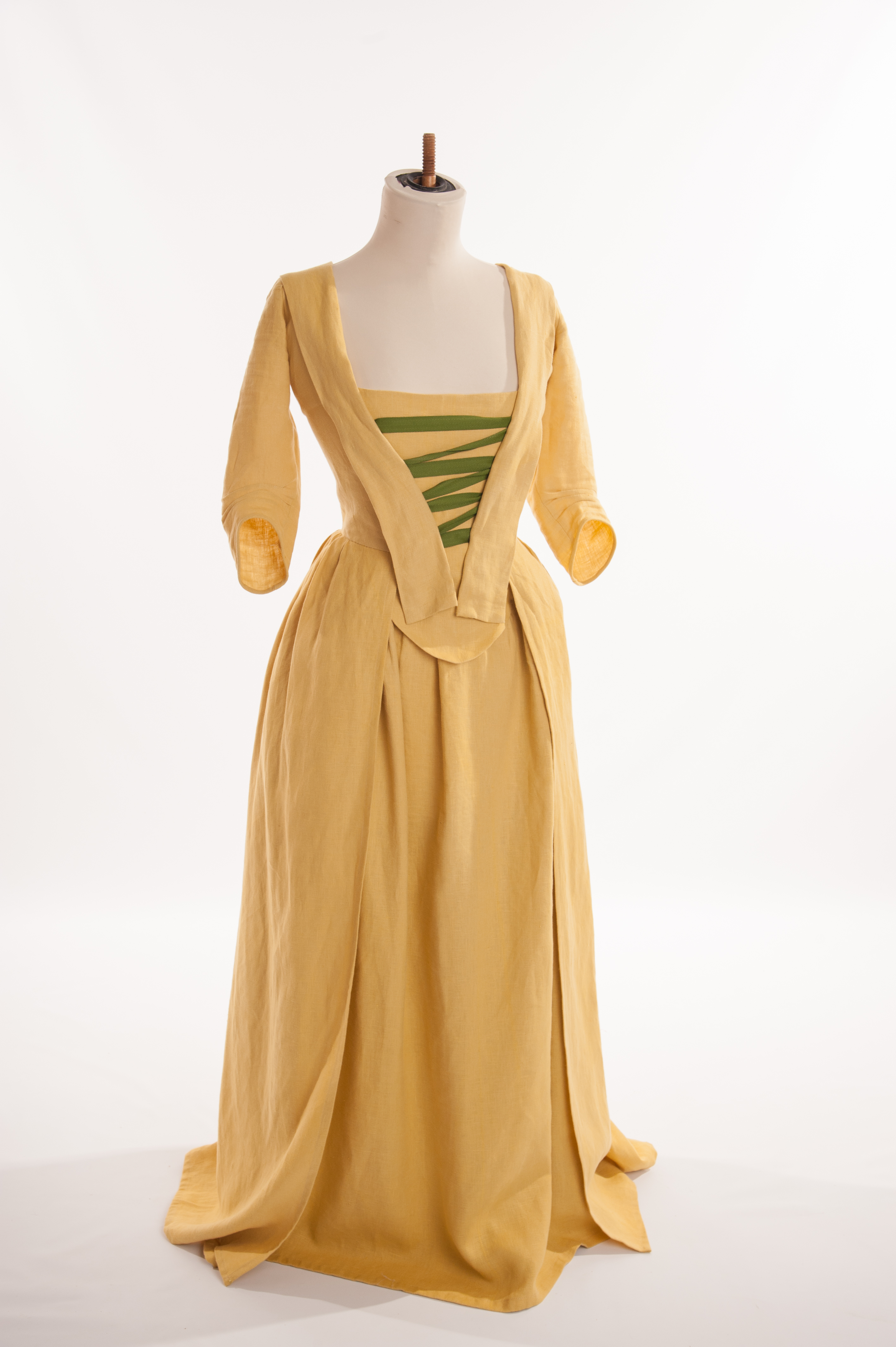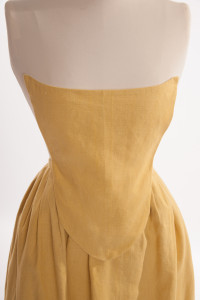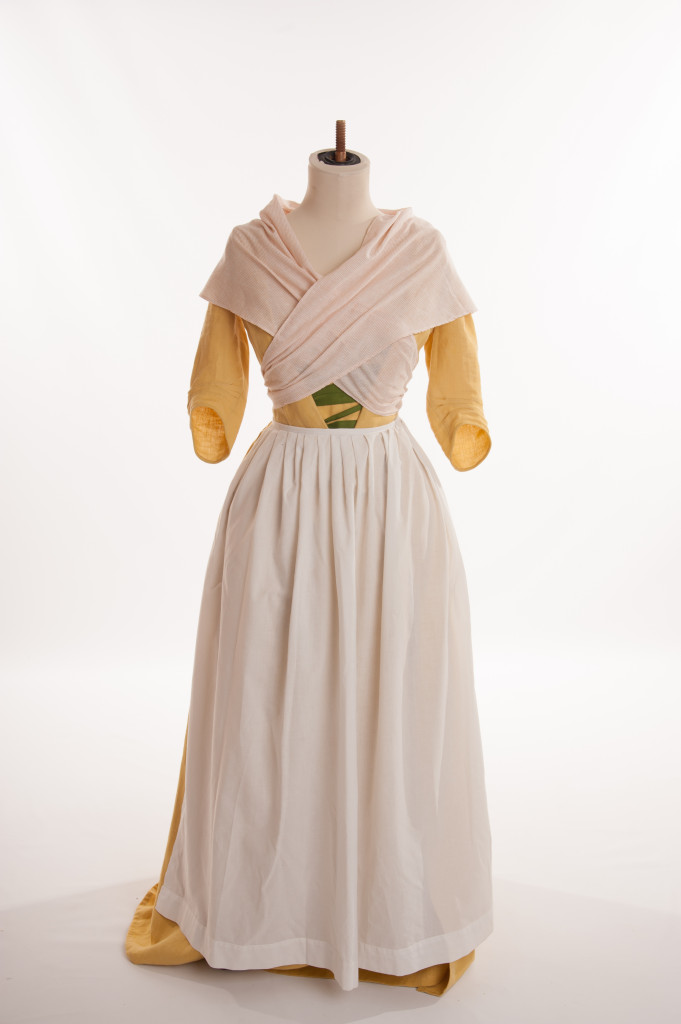How To Wear …The Sandby Dress..
or the Robe a l’Anglais!
Very similar to all Anglais’ and Sack Backs, this style of dress was the main prototype for dresses in this period. Both the Sack Back (Robe a la Francais) and the English Gown (Robe a l’Anglais) had the same form of opening at the Centre Front. This design, which featured Robings that came down from the shoulder and across the bust, was never meant to meet at the CF. The gap created between the Robings was filled in with a Stomacher. The angle of the Robings tended to draw nearer to the CF the further down the bodice it went and ranged from actually meeting at the CF somewhere below the waist, to still being worn several inches open. The Stomacher then was revealed beneath this opening where it was pinned flatly over the Stays. It could be laced, left plain, or have ties decorating over the top.
So, lets talk you through getting dressed:
* 1st Stage:
– First you need to get into your underclothes. We could leave you here with this simple statement but even this isn’t as easy as it sounds. 1st off it’s not
clear from the many images and paintings of the 18th century whether or not the petticoat was worn under or over the Stays. Many of the images where a lady is in half dress she is pictured in a petticoat worn under the stays. It is often a problem that stomachers don’t sit so smoothly and flatly as they seem to supposed to when they go over the bump of the petticoat laced on over. Wearing the Stays over the petticoat would reduce that bump and leave a smooth area to dress the Stomacher onto. It could also explain why a lot (not all) of the stomachers are longer and larger than you’d imagine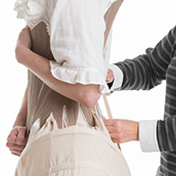 (And really not all of them – some are short and slender looking things). Modern Historians tend to dress the petticoat over the Stays (see Costumes Close Up by L.Baumgarten on p…..) which would makes sense to our understanding of corsetry being more of an underwear item. But this also fits in with the idea that lacing in a bulky petticoat would be particularly uncomfortable. This is an area we are still researching!
(And really not all of them – some are short and slender looking things). Modern Historians tend to dress the petticoat over the Stays (see Costumes Close Up by L.Baumgarten on p…..) which would makes sense to our understanding of corsetry being more of an underwear item. But this also fits in with the idea that lacing in a bulky petticoat would be particularly uncomfortable. This is an area we are still researching!
So with all of that discussion aside, lets look at how to get your Underclothes on.
Order of Under Garments:
- The Shift
- The Stays (possibly)
- The Hoops/Pads etc
- The Under Skirts
- The Pockets (down to class and personal opinion.).
Shift: The very definite first item you will need to put on is your Shift! These can vary a lot in styles but they always are a loose linen garment with short sleeves and an annoyingly large neck. You pull this on over your head and voila! the first stage is complete.
Shoes: Err…sounds strange but we also advise that you put any boots or shoes that require more than just slipping into BEFORE you get into your Stays. Just helping keeping life simple!
Stays: Next, we’d suggest putting your stays on. This is only because if the front point of your stays/tabs don’t happen to match your gown you are going to be able to see them. As already discussed we’re not yet sure how our ancestor’s dealt with this problem or if it’s just a modern mis-understanding of how stays were cut but it’s easier in general to place them on at this stage. If you have had your gown made purposefully to see your stays then obviously this is a different story. How tight you wear your stays is totally upto you. They were not designed to be as tight as Victorian corsets and you will soon get used to how tightly you like to wear them. Quite often we will lace ourselves in and then find halfway through the day that we feel we could go a bit tighter but let your body tell you when. Remember: Be kind to your body!
We have ‘Lacing Methods‘ in our ‘Useful Information Page‘ if you need help with this, and we also need to, perhaps, create a ‘How to’ page as well; as there are techniques for lacing yourself in, or, obviously, you can get someone else to do it for you.
Hoops: The next stage is another one that has question marks around it. If it is a cold event – then you’d be quite wise to wear a woolen/linen petticoat over your shift and stays so that it hangs closer to your legs. Also, some of the images show that if you are wearing a wide hoop it seems less likely that you’d be wearing layers of Under skirts. This decision is upto you and how you feel the general effect of your costume is.
Also, many of the original petticoats had silk ribbon ties along the top – we believe this was to reduce bulk at the waist. We have been unable to replicate this on all of our underskirts due to a lack of silk ribbon variety and also an expected look desired by our customers. Some of the later fashions (1760s onwards) veered more to the flatter fronts and only wanted fullness to the skirts at the hips and back. The more petticoats you wear the more bulk you have at the waist in general.
But here is when you’d tie on your Hip pads/Hooped Petticoats or Pocket Hoops that you may be desiring to wear. With this particular dress, probably only a thick Quilted Petticoat or Hip pads would be suitable – just to give a little bit of shape. Unless you’re doing 1750’s, a linen Day dress like this is unlikely to be worn with wide hoops. You can of course opt out for hip shaping as there are many working women images evidently wearing no form of hip padding.
Pockets: This does vary between class and also personal preference. Working class women seem to wear it over their Top petticoat but the slits in the gowns, petticoats and hoops suggests that they were also worn under these layers. Have a play and see what works for you.
Modern historians seem to place them under the petticoat.
* 2nd Stage:
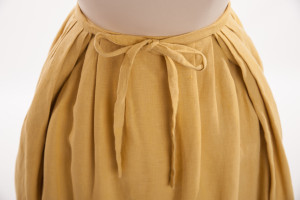
Back View
– Now that you are all corseted up, the next section is putting on the petticoat (unless of course you’ve already got it on!). Do this by stepping into the petticoat and bring the two back ties round to the front and fasten. Then bring the front two ties round to the back and fasten. You can gain access into your pockets through the side slits if you are wearing them in this position.
* 3rd Stage:
– Over your petticoat now you are about to pin on the Stomacher. If you ordered your dress with a hook and eye option please ignore this stage.
The use of pinning is rather useful. If you fancy wearing your stays a bit looser you can. If you have put on weight; fine. If you infact feel far slimmer today then this is also fine. Because the garment is pinned on it can be taken in or let out easily enough. The pinning starts here with the putting on of the Stomacher.
Some ground rules:
– Please remember when you are trying this that this will get better with practise!
– Do not try this really without Stays on. The use of Stays means that the way you move and what you are pinning onto should generally not allow you to stab yourself! If you don’t have stays on we have a problem. The answer: probably don’t pin!
– Use as many as you feel comfortable with – not the more the better; we don’t want you setting of metal detectors, but certainly don’t only use 2!
– In the pressing in of the pins try and get a good downward motion and make sure you can come back up, out of the fabric.
– Don’t Panic! By the time you finish pinning you will soon be able to tell the ones that didn’t catch right. Just re-do them.
Place your stomacher evenly over the centre of your Stays, making it a little higher than your Stays so that it hides them, you don’t really want to be seeing the edge. It only needs to sit a little higher though, don’t go choking yourself! Once in place begin to slide pins in at either side of the stomacher, into your Stays and catching the fabric over the top of the boning. If you are wearing your petticoat over then you can also pin into the waistband easily enough.We put about 5 either side, if that helps.
* 4th Stage:
– Next is the pulling on of the robe. If you have someone helping you then this is fairly straight forward. You pull the robe on like a jacket but your 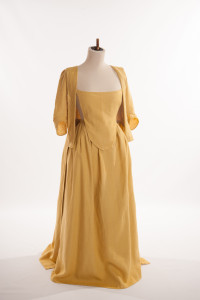 helper is able to hold down the sleeves of your shift while you do this. This makes a big difference. This robe has been based on a design after the 1750s where the sleeves begin to be a bit more fitted. This means that it is hard work wriggling down the shift sleeve. If you are on your own don’t panic, we do have a solution. (Well done by the way for getting into your stays all by yourself – give yourself a pat on the back!)
helper is able to hold down the sleeves of your shift while you do this. This makes a big difference. This robe has been based on a design after the 1750s where the sleeves begin to be a bit more fitted. This means that it is hard work wriggling down the shift sleeve. If you are on your own don’t panic, we do have a solution. (Well done by the way for getting into your stays all by yourself – give yourself a pat on the back!)
What we have found useful is a piece of tape with a good quality safety pin attached to it. Please make sure it’s good quality as it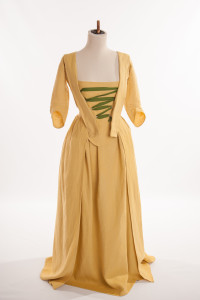 can be rather painful if it bends, breaks or comes undone while you are midway this procedure. But, very simply, once one arm has been safely put on (you tend to only need to do the one side as you can dress one half a bit more cleverly and therefore avoid the rucking), pin your shift sleeve and hold onto the rest of the tape with the same hand as the side you’ve just pinned. Slide you hand through the sleeve of your dress and and keeping the tape taut, you can then pull the sleeve up. This tautness holds the shift sleeve down from serious rucking and although you will still have to do a little bit of digging to pull the shift out all neatly, it is much, much easier.
can be rather painful if it bends, breaks or comes undone while you are midway this procedure. But, very simply, once one arm has been safely put on (you tend to only need to do the one side as you can dress one half a bit more cleverly and therefore avoid the rucking), pin your shift sleeve and hold onto the rest of the tape with the same hand as the side you’ve just pinned. Slide you hand through the sleeve of your dress and and keeping the tape taut, you can then pull the sleeve up. This tautness holds the shift sleeve down from serious rucking and although you will still have to do a little bit of digging to pull the shift out all neatly, it is much, much easier.
With your robe on, next you will need to lay the robings down over the stomacher and begin to lace yourself up. Lacing for the front can be done in a variety of ways. You can straight lace yourself (as seen in some of Sandby’s drawings) or use the classic lacing in technique like a shoe (also as seen in some of Sandby’s drawings).
Once laced you will need to do a final fun bit of pinning down the robings. This is easy enough; simply lift up the robings and slide in the pins, bringing them back up again, down the fold line of the Robings. This will allow the robings to sit nice and flat. We have taken a photo with and without this final bit of pinning so that you can see why it is essential.
And voila! you are dressed.
Well almost….
You also have the option and dressing like a true Georgian and utterly hiding your beautiful gown from view. Most ladies tended to wear some kind of neck cloth – only in the ultra court did this seem to drop out of fashion. They also had caps and hats on – take your pick. And most hidingly, they tended to wear a long apron. For a working woman this is virtually a must-have but even for the wealthy, a large chunk of the mid 1700s consisted of ladies wearing long white aprons. The difference from their working sister is that they got to have lovely fine, gauzy cottons or silks that shimmered and hinted at the dress beneath.
We do hope you have fun with your costume and any questions please feel free to ask!

